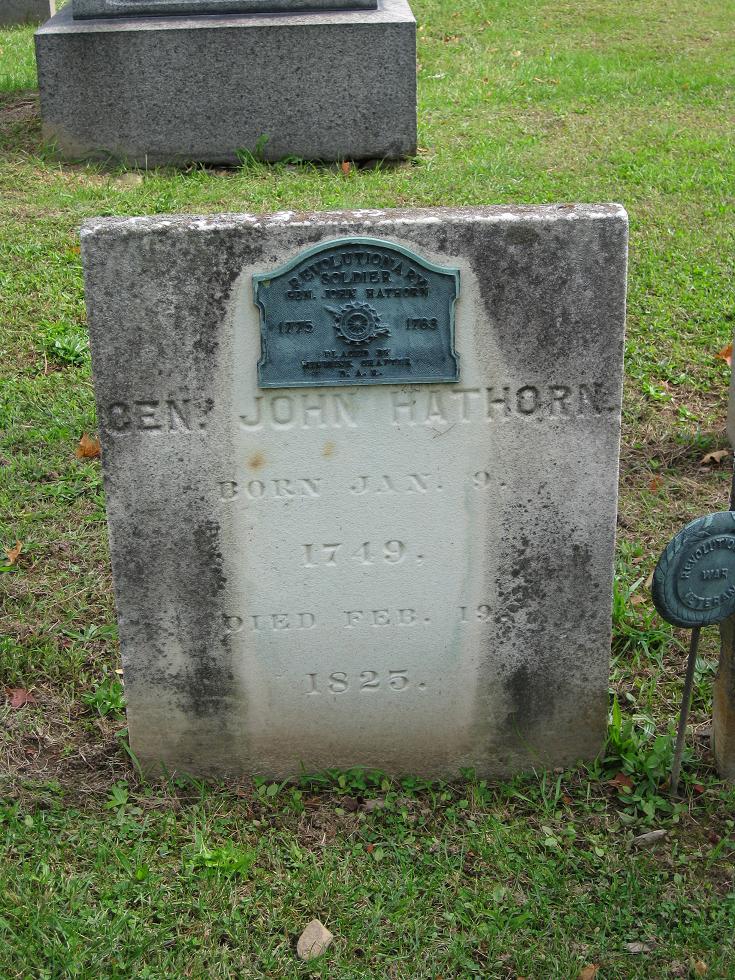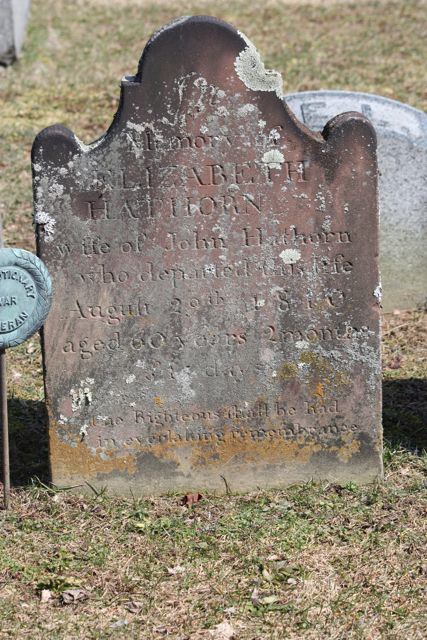JOHN HATHORN'S REVOLUTIONARY LEGACY by S. Gardner: INTRODUCTION
LEARN MORE!
Much of the story of Warwick in the Revolutionary War, the life and career of John Hathorn and his men and their families, is told in the book Pure Necessity: Revolution at Warwick, winner of the Greater Hudson Heritage Network's Award for Excellence. Available in local libraries and on Amazon.
A NOTE ABOUT GOSHEN PRECINCT MISSING RECORDS: Many of the earliest government records for the "Goshen Precinct" (which Warwick was a part of) were destroyed, first in in a fire on April 16, 1841, which burned the home of the Goshen Town Clerk, where records were kept. This was followed by a fire in 1843 that destroyed the Goshen Town Clerk's office.
WHO WAS JOHN HATHORN?
John Hathorn arrived in Warwick about 1770, a surveyor and teacher.
He was soon swept up in the events of the Revolutionary War. He was appointed as Colonel of the Orange County Militia in 1776. His minutemen helped guard the Ramapo Mountains and Sterling Forge, responded to alarms about Native American raiding parties along the Delaware frontier, and fought at the Battle of White Plains and other conflict areas.
He was one of the commissioners to determine the placement of the Great Chain across the Hudson at West Point, and his militia men helped build the buildings and fortifications there.
He was a commander of the disastrous Battle of Minisink, yet for the rest of his life was continuously voted into public office, a trusted and beloved representative of the people.
He served on the first and fourth Congresses of the United States and was acquainted with many of the important people of his day, attending the inauguration of Washington, and dining with the President as well as Vice President John Adams.
WHO WAS ELIZABETH WELLING HATHORN?
Elizabeth Welling, daughter of Thomas Welling, married this dynamic newcomer to her community in January of 1772. During his long and busy career he was frequently absent from home, so to Elizabeth, the children, and their servants and slaves fell the many tasks of running the farm and various business enterprises that they established.
A profile of her life was written by Caroline Welling Edsall in 1923.
In addition to the skills as household and business manager that she of necessity possessed, she could read and write. A letter discovered by researcher Hugh Goodman shows something of her daily life trying keep the family enterprises going. We have not been able to discover which repository owns this letter.
SITE OF HATHORN'S FORGE
According to Samuel Pelton's memoirs published in the Warwick Advertiser on July 16, 1903, the forge was on what became the Davis farm in New Milford, along Rt. 94 just past intersection of Hoyt Rd. The forge would have been near the stream.

ERSKINE'S MAP
Robert Erskine, Washington's map maker, drew several maps of the Warwick area and its strategic points. This one shows "Col. Hawthorns" house in the lower left corner, under "Warwick".
Section of "From Newborough (Newburgh) to Fort Lee, No. 36" by Robert Erskine. Collection of the New York Historical Society.
TIMELINE
|
1749 Jan. 9 |
Born January 9, 1749 Elkton or Wilmington, Delaware (place of birth in question) |
|
1772 Jan. 7 |
Marriage to Elizabeth Welling (Marriage license issued Dec. 18 1771 NY by NY Province) |
|
1773 |
John and Elizabeth Hathorn build house |
|
1775 |
Tax assessor for the Warwick section of Goshen Precinct. |
|
1776 Feb. |
Nominated as Lt. Colonel for the Continental Line to the Continental Congress, but appears he was given Col. in the Orange County Militia instead; is Chairman of the Committee of Goshen to the Continental Congress. |
|
1776 Feb. 28 |
Commissioned as Colonel. of Goshen Precinct regiment |
|
1777 April 25 |
New York Assembly at Kingston orders Hathorn and Allison to distribute seized tea to officers and troops. |
|
1777 Aug 10 |
Member of the first Legislature of the State of New York (Assembly) to create first Constitution of the State. |
|
1778 January |
Serves as a commissioner on placement of Great Chain across the Hudson at West Point for New York Provincial Convention |
|
1779 July 21 |
Order received from George Washington to send 100 of his men to guard British prisoners on their way to Easton. |
|
1779 July 22 |
Co-commander of the Battle of Minisink |
|
1780+ |
Served as one of three Commissioners of Forfeiture for the Middle District to dispose of confiscated loyalist lands. |
|
1783 - 1784 |
Speaker of the New York State Assembly (elected Jan. 2, 1783) |
|
1785 |
Votes in favor of abolishing slavery in New York |
|
1786 |
First of several terms in the New York State Senate; appointed one of the survey commissioners to settle land and border disputes in Chemung region of New York State. |
|
1786 Sept. 26 |
Brigadier General of the Orange County Militia 1787 |
|
1787 |
Serves on NYS Council of Appointment for Middle District; Foreman of the first Grand Jury at Goshen |
|
1788 |
Elected to Continental Congress; surveys, with James Clinton, Elmira region of New York State. Government changed form, so his first service was to the first Congress of the United States. |
|
1789 |
Serves on NYS Council of Appointment for Middle District; Appointed to the NY Commission for Holding Treaties with the Indians, attended treaty sessions with leaders of the Cayuga tribe. |
|
1789 April 23 |
Takes his seat in the first Congress of the United States, New York City. He supported Anti-Federalist positions, and became a Jeffersonian Republican. |
|
1789 April 30 |
Attends inauguration of George Washington at Federal Hall, New York |
|
1789 Aug. 21 |
Accepts invitation to dinner from Vice President John Adams |
|
1790 April 1 |
Dines with Washington, along with other New York representatives |
|
1791 April 19 |
Elected honorary member of the Society of the Cincinnati (exclusive membership of Continental Army officers) |
|
1793 Oct. 8 |
Major General of the New York State Militia |
|
1795 |
Elected to fourth Congress of the United States |
| 1800 Nov. | Elected to the New York State Senate |
|
1803-06 |
Land transactions with Solomon Townsend of the Sterling Iron Co. |
|
1804 April 3 |
Elected Warwick Town Supervisor |
|
1800 March 28 |
New York Legislature settles title of Hathorn lands. |
|
1810 |
Death of Elizabeth Welling Hathorn |
| 1815 Nov. 15 |
Hathorn unable to attend Lafayette's visit to NY & West Point |
|
1821 Nov. 19 |
Named to committee to recover Minisink Battle bones |
|
1825 Feb. 20 |
Death of John Hathorn |
LEARN ABOUT THE HOUSE
Click here to go to the History of Hathorn House page
NARRATED PRESENTATION
Click here to listen & view a narrated slideshow (approx. 20 mins or choose your own section to view).
"AN ENERGETIC MAN"
"In appearance he was about 5 feet 7 inches, of medium size, rather slender, fair complexion, brown hair & very bright keen gray eyes, of an easy amiable disposition, genial, impulsive, and very energetic." -- Letter of James B. Hathorn, grandson, in a letter to Lyman Draper in 1877. Draper Manuscript Collection Vol. 85 Item 46. Wisconsin Historical Society
"General Hathorn was very erect and preserved a military bearing, becoming stout in advanced life. He wore breeches and silver knee buckles and when in full dress, top boots." The Wellings of Warwick by Rev. A. A. Haines, 1899.
THE MISSING PORTRAIT
There is no known portrait of John Hathorn. This composite portrait of him done in 1907, eighty two years after his death, was painted by C. Brower Darst. The painting has been missing for many years, but we have photographs of it. It was composed from descriptions of him by his family and by the appearance of his grandchildren. This photograph of the portrait is in a private family collection.
A QUAKER
|
Stories handed down tell us that John, at least in later years, was a practicing Quaker, and adopted their dress. An eyewitness account recalls seeing Quaker meetings at the house, run by a woman. (Early Day Memories by Samuel Pelton, 1903.) In The Wellings of Warwick by Rev. A. A. Haines, he states that "One of the meetings remembered, to which he invited a number of his neighbors. They sat for a long time in silence and the meeting was closed without a word being spoken." He associated with the Townsends and the Sharps in New Jersey, both Quaker families. |






